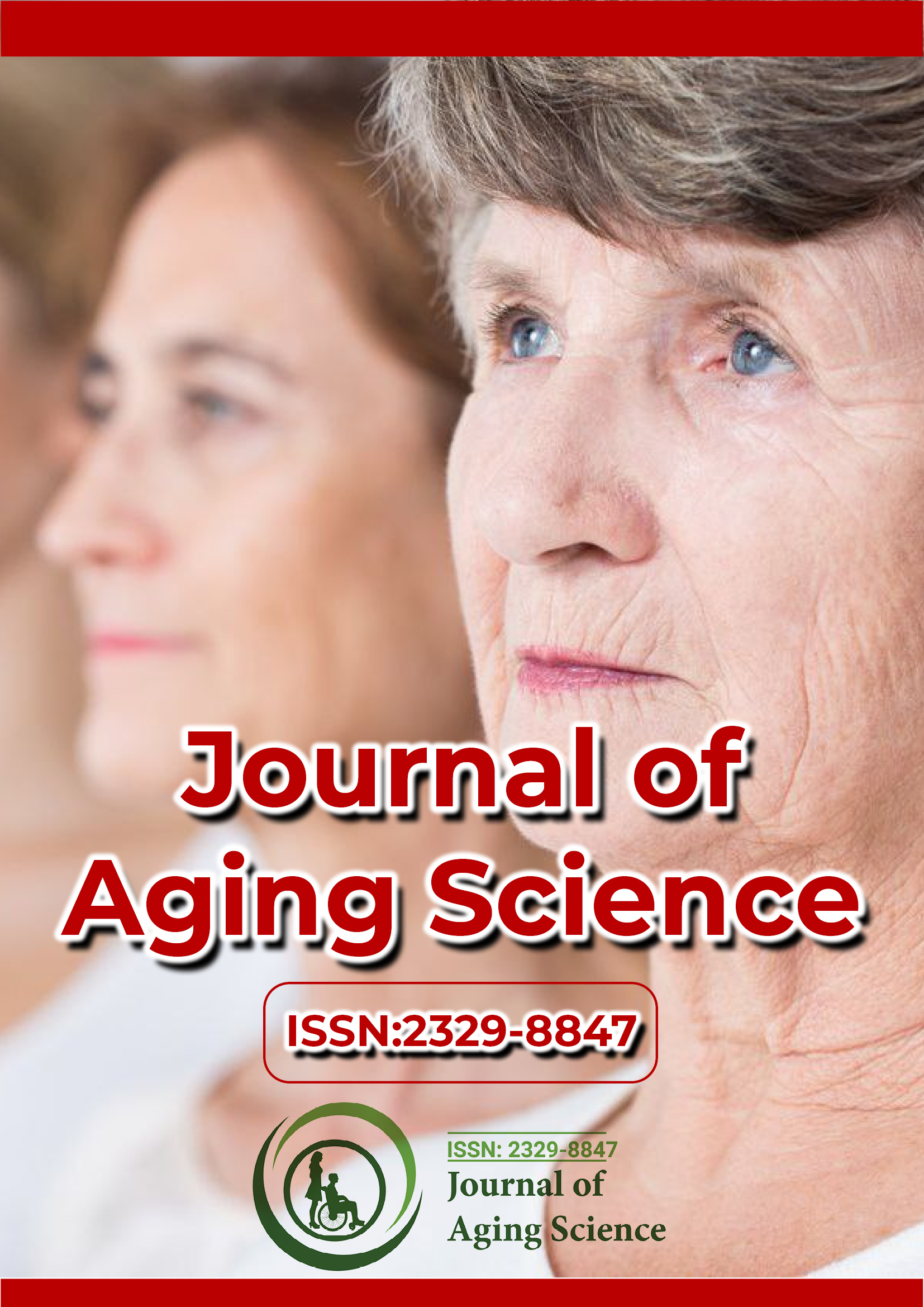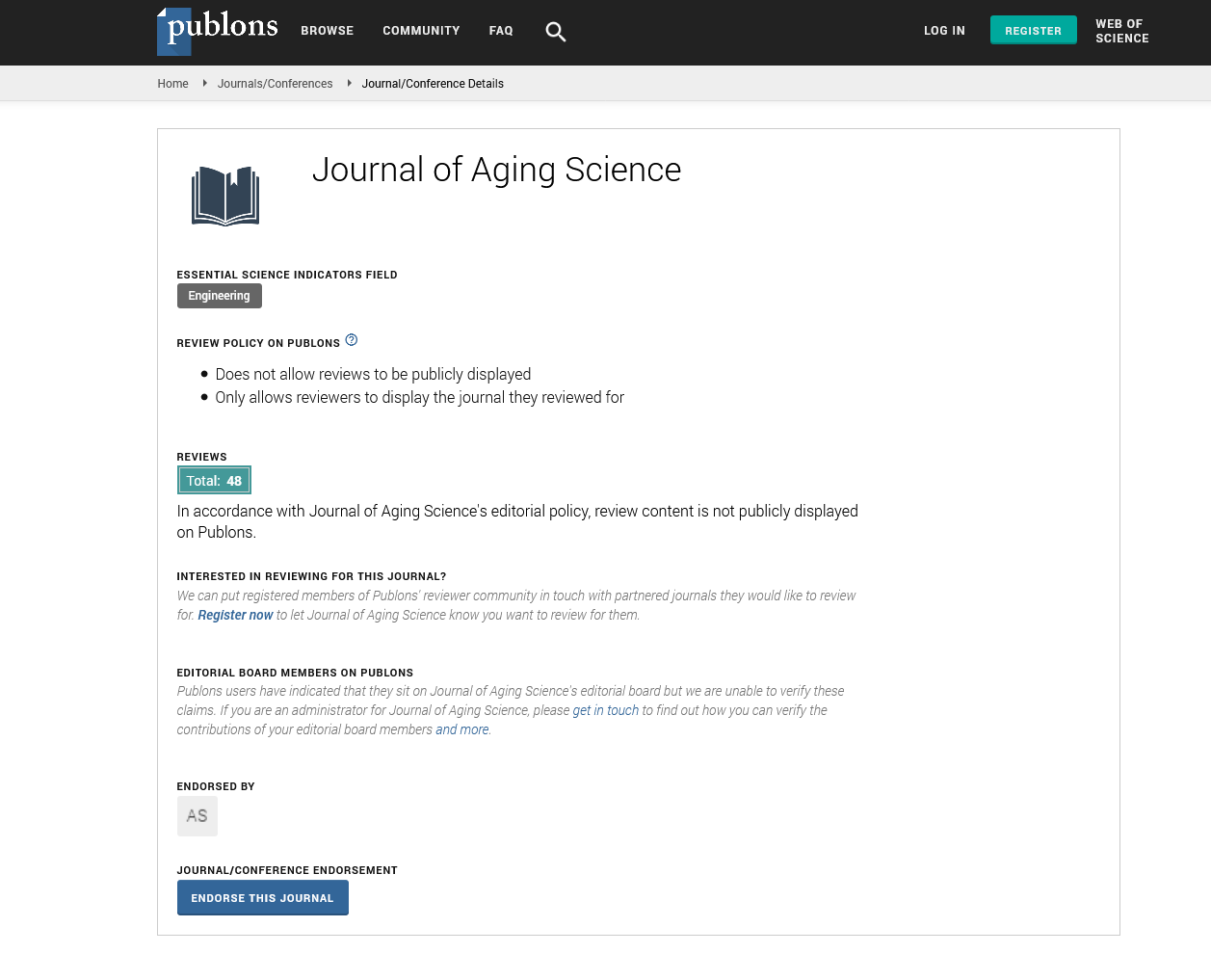Indexed In
- Open J Gate
- Academic Keys
- JournalTOCs
- ResearchBible
- RefSeek
- Hamdard University
- EBSCO A-Z
- OCLC- WorldCat
- Publons
- Geneva Foundation for Medical Education and Research
- Euro Pub
- Google Scholar
Useful Links
Share This Page
Journal Flyer

Open Access Journals
- Agri and Aquaculture
- Biochemistry
- Bioinformatics & Systems Biology
- Business & Management
- Chemistry
- Clinical Sciences
- Engineering
- Food & Nutrition
- General Science
- Genetics & Molecular Biology
- Immunology & Microbiology
- Medical Sciences
- Neuroscience & Psychology
- Nursing & Health Care
- Pharmaceutical Sciences
Opinion Article - (2025) Volume 13, Issue 3
Epigenetic Modifications in Aging: Molecular Signatures, Reversibility and Implications for Lifespan
Alex Richard*Received: 30-Jun-2025, Manuscript No. JASC-25-29560; Editor assigned: 03-Jul-2025, Pre QC No. JASC-25-29560 (PQ); Reviewed: 17-Jul-2025, QC No. JASC-25-29560; Revised: 24-Jul-2025, Manuscript No. JASC-25-29560 (R); Published: 31-Jul-2025, DOI: 10.35248/2329-8847.25.13.422
Description
Aging is accompanied by gradual changes in the brain that affect memory, learning, attention and executive functions. While some decline in mental performance is considered a natural aspect of aging, the boundary between healthy aging and pathological decline is not always clear. Age-related brain changes form the foundation for conditions such as Alzheimer’s disease, Parkinson’s disease and other dementias, which represent major challenges to public health worldwide.
One of the most consistent findings in brain aging is neuronal loss and synaptic dysfunction. Although the overall number of neurons does not dramatically decrease with age, structural changes within neurons and their synaptic connections reduce the efficiency of communication between brain regions. The hippocampus, which is central to learning and memory, is particularly vulnerable. Shrinkage in hippocampal volume is commonly observed in older individuals and is strongly linked to memory deficits.
Another key factor is reduced neuroplasticity. During youth, the brain has a remarkable ability to reorganize itself, form new synaptic connections and adapt to challenges. With aging, this plasticity declines, slowing the ability to acquire new skills or recover from injuries such as stroke. This reduced adaptability makes the brain more susceptible to cognitive impairment and neurodegenerative diseases.
The role of neurotransmitters also changes over time. Levels of dopamine, acetylcholine, serotonin and glutamate gradually decrease with age, disrupting signaling pathways involved in mood, memory and decision-making. For example, loss of dopaminergic neurons is linked with impaired motor control and contributes to Parkinson’s disease. Similarly, reduced acetylcholine transmission is strongly associated with Alzheimer’s disease, where memory loss and disorientation are dominant features.
Oxidative stress plays a significant role in brain aging. The brain consumes high amounts of oxygen and is particularly sensitive to damage from Reactive Oxygen Species (ROS). With age, antioxidant defense mechanisms weaken, leading to accumulation of oxidative damage to DNA, proteins and lipids in neurons. This damage contributes to cellular dysfunction, synaptic decline and eventual neuronal death.
Mitochondrial dysfunction further exacerbates oxidative stress and energy imbalance. Neurons rely heavily on efficient energy production and aging mitochondria lose the capacity to generate adequate ATP. This energy deficit limits neuronal repair mechanisms, reduces synaptic plasticity and contributes to cognitive decline. Mitochondrial DNA mutations accumulate with age, amplifying these detrimental effects.
Inflammation also plays an influential role in cognitive aging. Microglia, the resident immune cells of the brain, undergo functional changes over time. In youth, they protect neurons by clearing debris and supporting synaptic health. With aging, microglia often remain in a state of chronic activation, releasing inflammatory cytokines that damage neurons and disrupt communication pathways. This chronic low-grade neuroinflammation is increasingly recognized as a major driver of neurodegenerative diseases.
Another important factor is vascular aging. The brain depends on a constant supply of oxygen and nutrients through the cerebrovascular system. With age, blood vessels become stiffer and narrower due to atherosclerosis and endothelial dysfunction. Reduced cerebral blood flow impairs nutrient delivery and waste clearance, while small vessel disease contributes to white matter lesions that are strongly associated with cognitive impairment.
Protein misfolding and aggregation represent another hallmark of brain aging. Proteins such as beta-amyloid and tau, which should be cleared efficiently in younger brains, begin to accumulate abnormally in older individuals. These aggregates disrupt neuronal networks, impair synaptic signaling and initiate processes that eventually lead to Alzheimer’s disease. Similarly, alpha-synuclein aggregation plays a central role in Parkinson’s disease, contributing to motor and cognitive symptoms.
Despite these challenges, cognitive decline is not inevitable. Research indicates that lifestyle interventions can delay or mitigate brain aging. Regular physical exercise improves blood flow, enhances neurogenesis and stimulates the release of growth factors such as Brain-Derived Neurotrophic Factor (BDNF), which supports neuronal survival and plasticity. Cognitive training and lifelong learning help maintain neural circuits by continuously engaging the brain in problem-solving and memory tasks.
Nutrition also influences cognitive aging. Diets rich in omega-3 fatty acids, antioxidants and polyphenols support brain health by reducing oxidative stress and inflammation. Caloric restriction and intermittent fasting have shown neuroprotective effects in animal models, with some evidence suggesting they may slow human brain aging as well.
Pharmacological strategies are under exploration. Cholinesterase inhibitors and NMDA receptor modulators are already used in dementia treatment, while ongoing research investigates drugs targeting beta-amyloid and tau aggregation. Neuroprotective compounds such as resveratrol, curcumin and certain nootropics are being evaluated for their ability to preserve synaptic function and delay cognitive decline. Advances in regenerative medicine, including stem cell therapies and gene editing, hold long-term potential, although clinical applications remain in early stages.
Social engagement and emotional well-being also have measurable impacts. Older adults who maintain strong social networks and participate in community activities demonstrate slower rates of cognitive decline compared to those with social isolation. Stress reduction practices such as meditation, yoga and mindfulness have shown beneficial effects on both cognitive function and brain structure.
Conclusion
Cognitive decline is one of the most significant aspects of aging, shaped by multiple biological processes including oxidative stress, mitochondrial dysfunction, neuroinflammation, protein aggregation and vascular changes. While these mechanisms contribute to memory loss, slower learning and reduced executive function, not all individuals experience the same degree of impairment.
Evidence suggests that brain aging can be influenced by lifestyle, diet, physical activity, cognitive training and social factors. Pharmacological and regenerative therapies are expanding the potential to intervene in age-related decline, offering hope for delaying or even reversing some aspects of neurodegeneration.
Ultimately, preserving cognitive function into later years depends on a combination of healthy living, medical advances and social engagement, aiming not only for longer life but also for sustained mental capacity and independence.
Citation: Richard A (2025). Epigenetic Modifications in Aging: Molecular Signatures, Reversibility and Implications for Lifespan. J Aging Sci. 13:422.
Copyright: © 2025 Richard A. This is an open-access article distributed under the terms of the Creative Commons Attribution License, which permits unrestricted use, distribution and reproduction in any medium, provided the original author and source are credited.

